Chapter 15: Climate Change and Sea Level Rise
Purpose
Much of Ogunquit’s identity, economy, and population are inextricably tied to, dependent on, and concentrated along its coastline, making coastal climate impacts of critical concern for the town. As such, this chapter will focus on sea level rise rather than climate change in general.
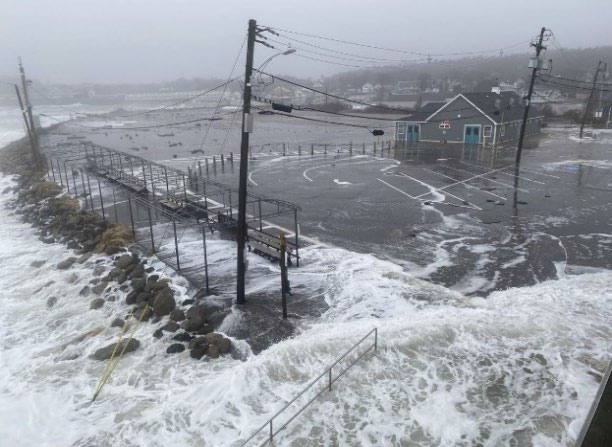
Climate change will exacerbate existing hazards and issues, but also cause new risks and challenges for Ogunquit. Intense precipitation events could cause more storm water run off, amplifying existing water quality problems.
Increasing storm intensity and frequency will likely cause more power outages that last longer, disrupting the community’s normal activities, impairing public safety, and straining local resources. Shifting terrestrial habitat conditions and warming ocean temperatures could encourage the expansion of existing invasive species, like green crab and knotweed, and enable the arrival of new invasive species, jeopardizing traditional recreation and fishing activities like shellfish harvesting. Extreme heat and drought will threaten public health and natural resources.
Extreme heat and drought will threaten public health and natural resources.
The Community likely has an elevated level of vulnerability to natural hazards and climate impacts.
While climate change will likely impact every facet of the community in some way, those impacts will not be felt evenly across the community and will not be uniformly distributed among population groups. Individuals who already have increased social vulnerability or have been traditionally marginalized and underrepresented will be disproportionately affected by climate hazards, as they generally have lower capacity to prepare for, respond to, and recover from hazard events and disruptions.
Those populations include children and older adults, households with lower or moderate incomes, individuals with pre-existing health conditions, people of color, and those living alone. Ogunquit has relatively high percentage of older individuals (65+) living alone, characteristics that contribute to elevated social vulnerability as they tend to be associated with social isolation and decreased ability to prepare for and respond to storms, flooding, and other natural disasters. As a result,the community likely has an elevated level of vulnerability to natural hazards and climate impacts.
Ogunquit has a relatively high percentage of older individuals (65+) living alone, characteristics that contribute to elevated social vulnerability as they tend to be associated with social isolation and decreased ability to prepare for and respond to storms, flooding, and other natural disasters.
Sea Level Rise Background
Climate Change and Sea Level Rise
Ogunquit can expect to see a 15- fold increase in coastal flooding by 2050.
Sea level rise is a global phenomenon driven by two primary factors related to climate change: an increase in the volume of ocean water caused by the melting of land-based ice sheets and glaciers, and thermal expansion of seawater as it is warmed by increasing global temperatures. While sea level in Maine has been rising in the long-term, over the past few decades the rate of rise has accelerated. Nearly half of the documented sea level rise that has occurred locally over the past century has happened since 1993, representing a rapid increase in the rate of change.
That rise is increasing the frequency of nuisance or high tide flooding, with southern Maine seeing four times as many nuisance flooding events over the last decade compared with the average of the past 100years. According to a State 2020 study, under intermediate global greenhouse gas emissions scenarios there is a 67% probability that sea level will rise between 1.1 and 1.8 feet by 2050, and between 3.0 and 4.6 feet by the year 2100 relative to 2000 water levels, with higher sea level rise amounts possible. With that rate of sea level rise, not accounting for increased intensity and frequency of storms, Ogunquit can expect to see a 15-fold increase in coastal flooding by 2050. Those scenarios do not account for more intense rainfall that climate change is bringing to the region, which will exacerbate flooding.
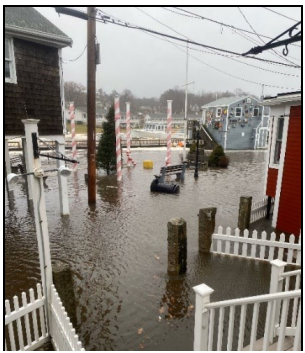
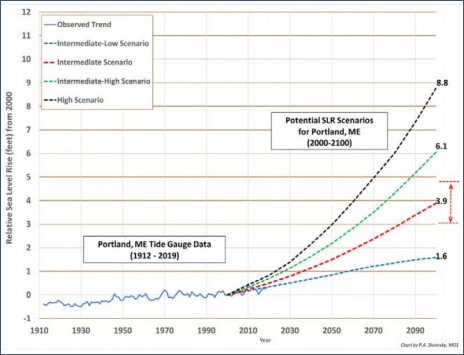
Graph illustrating historical sea level rise in Portland (solid blue line) and scenarios from 2000-2100 with central estimates (50% probability of being met or exceeded) for low-intermediate to high sea level rise scenarios. The likely range of 3.0 to 4.6 feet (67% probability of sea level rise falling between these values) for the intermediate scenario is shown as a dashed red arrow and red lines on the right side of the figure. Values are presented in tenths of a foot and relate to a year 2000 starting point. Scenario data from the
U.S. Army Corps of Engineers Sea Level Change Calculator based on sea level rise scenarios developed for the 4th U.S. National Climate Assessment. (Source: Scientific Assessment of Climate Change and Its Effects in Maine prepared by the Maine Climate Council Scientific and Technical Subcommittee. Chart by P. Slovinsky, Maine Geological Society)
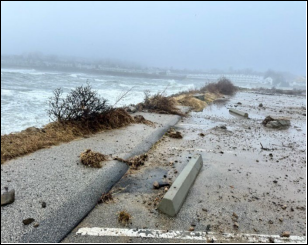

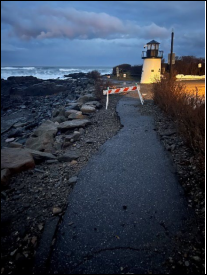
Sea Level Rise Impacts on Ogunquit
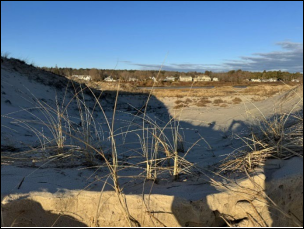
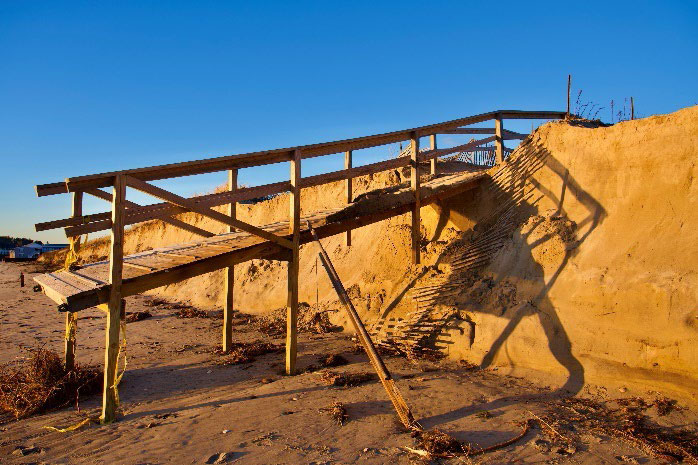


Impacts to Marshes
Storms and Potential Hurricanes
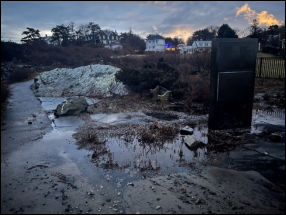
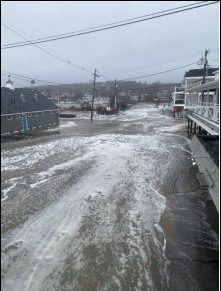
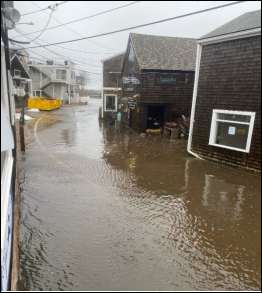
Climate change poses an existential threat to Ogunquit. The rise of sea level is of concern for the Town, as it threatens the coastal community’s character, economy, public safety, infrastructure, and natural resources. Ogunquit is already taking action to plan for climate change by participating as a founding member in the Southern Maine Regional Sustainability and Resilience Program, enrolling in the State’s Community Resilience Partnership program, undertaking watershed studies and stormwater management improvements, conserving important natural areas, participating in regional coastal resilience planning projects, converting streetlights to LEDs, pursuing funding to install solar panels on the Dunaway Center, converting portions of the municipal fleet to electric vehicles (EVs), and installing EV charging stations in municipal parking lots. Continued commitment to climate action will be critical in the future to ensure the sustainability and resilience of the community.
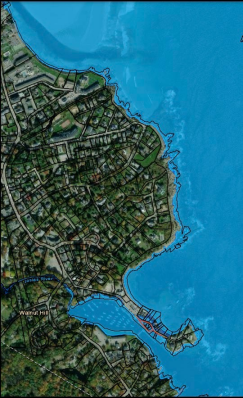
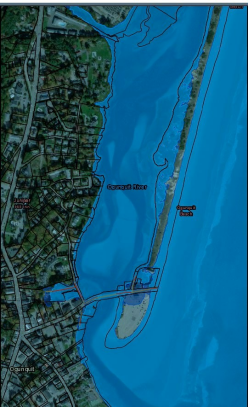
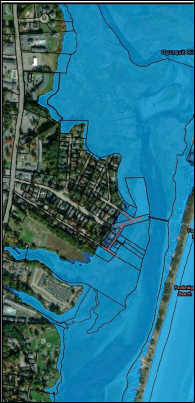
Projected inundation from 1.6 and 3.9 feet of sea level rise combined with storm surge from the 1% annual chance event overlayed with Ogunquit parcels. Impacted roads account for bridge elevation, as LiDAR was used to confirm whether a bridge would be overtopped based on bridge deck elevations and the water surface elevations of the inundation scenario. If the inundation boundary appears to ‘cover’ a bridge, the bridge is only projected to be inundated by water if it is shown as red or orange on the map. (Source: SMPDC. 2022. Economic Resilience Assessment and Plan for Coastal York County).
Goals, Policies and Strategies
Goal
- Toacknowledge and respond to the full potential of climate change impacts on residents,
Policies:
- Tocontinue to monitor the effects of sea level and climate change and their impact on the Town of
- Reviewand update polices and ordinances
- Usecost benefit analysis to make decisions regarding any new retrofitting and fortification as needed due to sea level rise or climate change.
Strategies:
- Priority: 1-5 with 1 being the highest priority.
| Description | Priority | Responsibility |
| Continue to work with Maine’s southernmost coastal communities and SMPDC to assess impacts of coastal hazards, including sea level rise and erosion. Develop strategies and nature-based solutions for making the region(s) more resilient to coastal hazards and research grants to fund these solutions. | 1 | Town Manager |
| Identify and prioritize Ogunquit’s most vulnerable areas for sea level rise such as: · Ogunquit Beach, Footbridge Beach and North Beach and parking lot, roads leading to the beach, residential and commercial businesses in beach area. · Perkins Cove and waterfront, Perkins Cove Road, Parking lot, commercial and residential buildings. · Rocky coastline, especially in the area along the Marginal Way path which features basaltic dikes, glacial features and sedimentary rocks. · Ogunquit Sewer Treatment Plant. Ogunquit Sewer District has already purchased land outside of the floodplain, relocated electrical equipment and is planning on staging emergency equipment off site. Develop plans/solutions to protect the people, infrastructure and natural resources in vulnerable areas. | 2 | Town Manager |
| Analyze the economic impact of sea level rise and climate change on identified vulnerable areas and develop long- range plan(s) to combat negative economic changes to the Town and residents. Identify and secure the type of capital investment needed to safeguard at-risk infrastructure. | 3 | Town Manager |
| Develop an evacuation plan for residents and visitors in areas vulnerable to sea level rise. | 4 | Town Manager |
| Continue to increase the use of renewable energy resources (such as solar panels on Town structures and in parking lots), make carbon-free decisions and use cost effective materials created from recycled material. Educate and encourage homeowners to do the same. | 5 | Town Manager |
| Develop an education plan, in collaboration with residents and businesses, to educate residents and businesses as to what steps the Town is taking to address and plan for climate change and sea level rise. | Sustainability Committee | |
| Annually review floodplain management and land use ordinances to protect vulnerable areas, especially set-back areas in shoreland areas. | CEO | |
| Continue to research and recommend suggestions to reduce carbon emissions, beach erosion, soil erosion and maintain Best Management Practices (BMP) for stormwater run-off to Select Board. | Sustainability Committee | |
| Educate and enforce the Maine Statute that prohibits idling vehicles. | Police Department | |
| Encourage the planting of additional trees on Town property and residential property to provide shade and conserve energy. | Conservation Commission | |
| Increase fines and tighten enforcement for trespassing on the dunes. | Town Manager |
